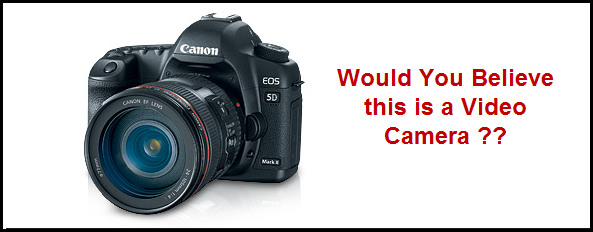
Video comes to SLR
Yes indeed, that is a Canon digital SLR with replaceable lenses – and it is a pretty good video camera. The Canon EOS 5D Mark II is probably the epitome of what has become a gold rush of digital SLR cameras that are currently supporting video capabilities. Nikon has the D5000 (AVI bloat and panning problems) and Canon has the Canon EOS500D(auto-focus limitations and limited size of video clip) as recent very competent but still incomplete intros. And these are just two examples of the flood of DSLRs that are offering some video capability (think Pentax K-7 and Nikon D90) – but also have the start-up problems that most camcorders have dealt with many years ago.
This blog was one of the earliest in predicting that video would come to DSLRs and that it would be popular. Proof that it is sometimes dangerous to see the incarnations of what you wished for. Not that video in DSLRs are a bust … but rather there are some … uhhhh teething problems.
Here is a quick laundry list of limits and problems that are effecting the current crop of Digital SLR with video capabilities:
1)Cannot match the very low-light shooting capabilities of camcorders
2)Sound recording equipment is monaural and tends to pickup in-camera noises
3)Auto-focus and subject tracking are slow or non-existent
4)Camera shake control and prowess is not nearly equal to camcorders
5)Capacity for clips is often a fraction of camcorder capabilities
6)Zoom, panning, and fades can be problematic
In defense of the digital SLR video-recordings, there are three salient advantages:
1)The price for interchangeable lens of very high quality is much less costly than camcorder offerings
2)the top-end SLR full frame camera sensors are equal to or batter than top-end camcorders
3)the ability to control aperture and color balance is a notch or 2 better than camcorders
What remains to be seen is how on camera lighting and camera mounting will be adapted to both DSLR and camcorders as they start to merge in functionality. Also it will be interesting to see which side picks up the others best traits – most digital SLRs now have great live-LCD shooting screen that can swivel. Some camcorders are using ever more sophisticated camera processors “inspired” by digital SLRs. Also watch for remote control mechanisms/sensors (motion and luminisoty change/trigger events) and the ability to store larger and faster recorded clips (shutter speed in the 100 frames per second or greater range) to appear in the market. The Casio EX/F1 already shoots at 300 to 1000 fps but at a loss of image size.
In sum, camcorders and DSLRs are meeting – will the union be progressive or will a whole new image recording experience start to emerge as drastic as the move from analog to digital camaera ? Only the Shadow knows ….
